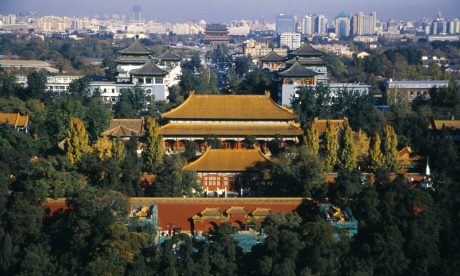
Let your budget stretch as far as your imagination on a trip to China, with these freebies from Clare Wilson
Go to Ritan Park first thing in the morning for a taste of real Chinese life. Named after its Temple of the Sun, the park dates back to 1530 and is one of Beijing’s oldest. You'll see everything from Tai Chi and Mah-Jongg (an ancient puzzle game), to ballroom dancing, sword-fighting, and community singing if you're lucky. There are ponds and pines for quiet contemplation plus a climbing wall and outdoor gym for fitness fanatics – a favourite with Chinese pensioners. (Chaoyangmen subway station)
This busy shopping district may be a monument to consumerism – and where China’s wealthy come to shop – but there’s plenty to see for free. Under an arch at the southern end is ‘Snack Street’, best visited in the evening to watch people trying a variety of foods on sticks: from scorpions and silk-worms to a nice bit of snake. Further north on Wangfujing is St Joseph’s Cathedral, a 17th century edifice that has survived earthquakes, fires and rebellions. Now it’s a great place to watch models posing for bridal shoots. (Wangfujing subway station – Line 1)
Undoubtedly one of Beijing’s sightseeing icons, Tiananmen Square is consequently the best place for people watching. Brave the crowds and go at sunrise or sunset for the raising/lowering of the national flag. Chances are you’ll be asked to pose for photos with Chinese tourists as well as taking your own. Watch out for scams: ‘art students’ and friendly couples will often invite you for tea ceremonies or to see art exhibitions and leave you with a bill to make your eyes water. (Tiananmen Square East or West subway station – Line 1)
Walk north from Tiananmen Square to the gargantuan palace complex known colloquially as the Forbidden City or more formally as the Palace Museum. Go under the famous portrait of former communist leader Mao Zedong and take in the scale of the outer courtyard – you don’t need to pay until you go into the city itself at the Meridian Gate. (Tiananmen Square East/West subway station – Line 1)
Visiting a market in Beijing is almost a rite of passage. At the Silk Market you'll definitely be harangued in English and are likely to be physically dragged into stalls to look at things. You’ll hear every sob story under the sun but you can get a better deal than at other English-speaking markets. Alternatively at the Zoo Market, you'll need to speak some Mandarin and have a compass to get out again, but there probably won't be another Westerner in sight. (Silk Market – Yong’anli subway station; Zoo Market – Beijing Zoo stop)
Houhai and neighbouring Xihai lakes, located to the north of the Forbidden City, are great on a hot afternoon: dive in and swim with the locals (if you’re feeling brave) or just go for a stroll around the shores. There are also pedalos and bikes for hire if you want to splash out, and plenty of rooftop bars to grab a beer later on.
Houhai isn’t connected to the subway system (yet) so getting there, either by bike or bus, will be an adventure too.
The legacy of the 2008 Olympics includes an excellent subway system and some fantastic architecture. The best examples are the National Stadium (nicknamed the Bird’s Nest), built from 36km of unwrapped steel, and the National Aquatic Centre, dubbed the Water Cube. You can go inside both, though charges apply, so the best time to see them for free is at night when both buildings are illuminated. (Olympic Park subway station)
Their numbers may be dwindling, but there are still places to see the city’s historic hutongs – narrow alleyways – thanks in part to a resurgence of interest from travellers. The restored buildings along Nanluoguxiang (near the Drum and Bell Towers) combine hip and historic reasonably sympathetically; to the area south of Tiananmen Square you’ll find the narrowest alleyway in Beijing, Qianshi Hutong (just off Zhubaoshi Jie); or the most crooked alley in Beijing, Jiuwan Hutong, which is off Liuxue Lu.
To the north east of the city is the 798 Art District. This collection of galleries, cafes, public art and quirky boutiques is the place to get to grips with contemporary Chinese art and culture. Inside a converted Communist-era electronics factory and other industrial buildings, you’ll find kitsch references to the proletarian roots of the district jostling with the cutting-edge of China’s art scene.
There are generally no admission fees, but be aware that galleries may be closed on Mondays. 798 isn’t connected to the subway system yet either; the easiest way to get there is by taxi.
Maliandao Tea Street claims to be the largest tea market in northern China, and with over 900 tea shops and stalls selling all imaginable varieties of Chinese tea, including green tea, jasmine, pu’er and oolong, it’s hard to disagree. Wander and try samples of different varieties, or tempt yourself with some beautiful tea sets, teapots and paraphernalia. (To find the market building, look for the statue of the 8th-century sage Lu Yu, who wrote The Classic of Tea, the first book on growing, preparing and drinking tea. Changchunjie subway station.)
Beijing's top 10 experiences | Inspire me... More
Travel in China: frequently asked questions | Destinations... More
10 foods travellers may be forced to eat | Inspire me... More
Check out our China travel guide for inspiration and advice | Plan a trip... More
The 8 oddest food markets in the world (and what to buy there) | Inspire me... More